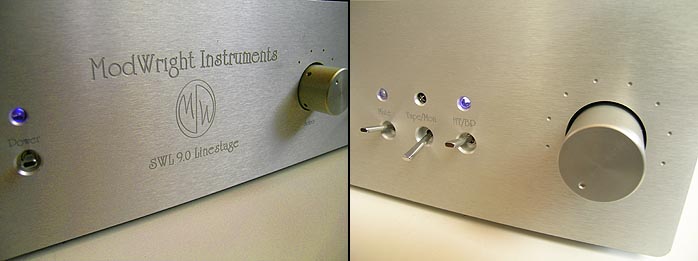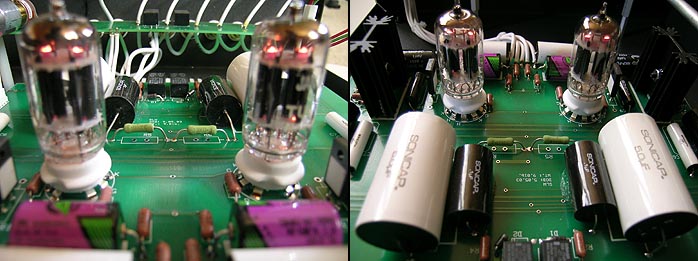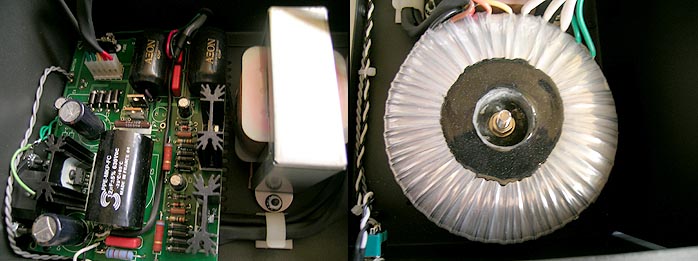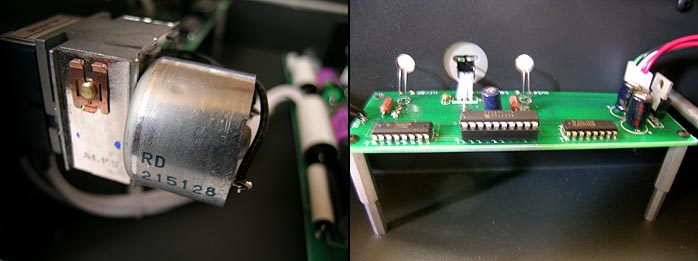|
|
|
|
This review page is supported in part by the sponsor whose ad is displayed above
|
|
 |
|
 |
|
|
|
 |
|
 |
|
|
|
Reviewer: Srajan Ebaen
Source: Accustic Arts Drive-1; Audio Aero Prima SE [on loan]; Consonance Droplet CDP 5.0 [on review]
Preamp/Integrated: Bel Canto PRe2; Audiopax Model 5
Amp: Audiopax Model 88; Bel Canto Design eVo 4 Gen2; Red Wine Audio Clari-T Custom [on review]
Speakers: Zu Cable Druid Mk4
Cables: Stealth Audio Varidig S/PDIF, Stealth Audio Indra (x2),Zu Cable Ibis speaker cable; ZCable Hurricane power cords on both conditioners
Stands: 2 x Grand Prix Audio Monaco four-tier
Powerline conditioning: 2 x Walker Audio Velocitor S
Sundry accessories: GPA Formula Carbon/Kevlar shelf for transport; GPA Apex footers underneath stand and speakers; Walker Audio SST on all connections; Walker Audio Vivid CD cleaner; Furutech RD-2 CD demagnetizer; WorldPower cryo'd Hubbell wall sockets; Musse Audio resonance dampers on DUO subs
Room size: 30' w x 18' d x 10' h [sloping ceiling] in long-wall setup in one half, with open adjoining living room for a total of ca.1000 squ.ft floor plan
Review Component Retail: $1,800 standard, $2,200 for SE version as reviewed
|
|
|
|
|
|
 |
|
Price-conscious punters know full well that the Asian invasion of beautifully styled components can save a bundle compared to home-grown offers. But there's one thing our capable friends overseas don't yet have - bundles of hardcore high-end experience. They can execute textbook-perfect circuits and lavish fancy finishes on them we're hard-pressed to duplicate. However, to truly compete with the best of the West means making up for decades of tweaking textbook circuits and in some cases throwing out the good book entirely. There's no shortcut for putting in that time. Not really. Reverse-engineering can copy a circuit but understanding why it does what it does and which parts are responsible requires countless years of - well, hands-on immersion in this tweakoid subject. And sans the context of knowing what the state-of-the-art is, you'd still be operating in relative limbo even with the very best of intentions.
|
|
 |
|
That's precisely why savvy gents like Underwood Wally aka Walter Liederman have successfully developed an entire business model that relies on identifying cost-effective foreign component platforms only to have our best domestic modifiers work them over, mostly to strategically upgrade those parts the specialist tweaker deems hold back the stocker's ultimate potential. Mind you, that's post-op tweakeroo. Certain cynics raise a valid question. If these modifiers are so bloody brilliant at improving other people's work, how come they never design their very own components from the ground up?
|
|
|
 |
|
Dan Wright, one of the most respected domestic modifiers, now throws down the gauntlet. His new 5687-based linestage with home-theater bypass and optional remote volume/mute in the SE version is a pre-modded assault at the affordable state-of-the-art. It incorporates everything Dan has learned over the years from hotrodding other people's creations. From the stout packaging to the accompanying documentation, from internal workmanship to the exterior fit'n'finish, the SWL9.0 is a full-on production piece such as you'd expect from established firms like Quicksilver Audio.
|
|
|
 |
|
The only aspect that, to some, could perhaps indicate Dan's fresh emergence into the manufacturing arena is the generic One For All remote. Designing his own metal casing as well as writing the IR codes would have added complexities and most assuredly cost. The ModWright man thus became the Dudley DoRight dude. He saved his target audience some bread and while the remote was originally only part of the SE package, it's now standard even at $1,800.
|
|
|
 |
|
No retina-scan idiot lights either for Dan. The power, mute and bypass-engage LEDs are a pale rather than piercing blue, properly padded down with resistors one assumes. No transducer shock therapy neither. Upon power-up, the motor-driven Alps pot automatically returns to zero. And no stir-fry of the twin triodes, either. An auto-mute circuit slowly ramps up to thermal stability over 45 seconds. And for those who like to make copies, the SWL 9.0 includes a full tape loop with front-panel tape monitor switch. Have subwoofer or wish to biamp? This pre obliges with twin main outputs. Have more than four sources? Now you're pushing it, buddy. Go buy some $6,000 pre. This one's a sane offering for the real world, with just the kind of features most need and none that most would find redundant. The latter includes balance.
|
|
|
 |
|
The Class A circuit is choke-regulated, with fixed battery bias for the gain stage, a 'Mu" type gain/buffer stage -- this part is openly credited to project consultant Alan Kimmel --, regulated DC heaters and discrete FET-regulated B+ rails. Gain is 15dB, input Z 50K, output Z 600 ohm, noise level -122dB, frequency response 17Hz - 200kHz +/- 1dB, dimensions are 17" W x 12" D x 4" H and weight is a considerable 24 lbs.
|
|
|
 |
|
Tube rollers beware: This preamp only accepts 5687s and their derivatives, the 6900 and 7119 valves. Anything from the 12AX7/6DJ8/6922 family is bad juju and will unleash evil spirits that'll damage your unit since 12AX7-type pin configurations do not match that of the specified tube. Both Ray Samuels of Emmeline and Roger Hebert of Wyetech Labs work with the 5687 as well. It is a high-current, hi-drive small triode with very linear performance. It sometimes finds itself dubbed a "6SN7 on steroids" even though it is not really related to the latter nor can it substitute for it.
|
|
|
 |
|
The SWL9.0 is one quiet preamp, too. It instantly acquitted itself on my 101dB Zu Druids. It's a true gentleman in this realm so vital to high-eff speaker lovers like myself. In tandem with its exceptionally low noisefloor, the gain structure is scaled such as to afford plenty of open range before things get really loud even into such uncommon speaker loads. The parts police will take admiring note of FRED and Schottky diodes, metal-film Vishay resistors, Teflon film Sonicaps, ceramic tube sockets and other examples of the serious modder's art.
|
|
|
 |
|
At +/- $2,000 for the standard and SE version, the Modwright Instruments SWL 9.0 is an American heartland product. It's not cheap but it's certainly also leagues removed from silly money. It arrives with serious ambitions to take on far pricier units, is solidly built, very well executed and deliberately not part of the flash'n'glitz crowd. Concurrent with my review loaner dispatch, Dan Wright has also delivered units to Todd Warnke of EnjoyTheMusic.com and Bascom King of The Audiophile Voice. Stay tuned then not just for my findings but those of my colleagues as well. Mazel mazel - good things...
I asked Dan to share some background on this, his first production design project. Here's what I learned: "Both the standard and SE models now come with R/C volume. The extra $400 going to the SE version buys you the Teflon caps, all poly-capped power supply, precision metal film resistors in key locations in the signal path, high-end signal wire and parts upgrades throughout. Bottom line, the basic unit is the unit I was able to build to meet the price point that I initially set out to achieve. The SE version represents what I really wanted to take to market.
The preamp design project was in process for about three years total. It was with Alan Kimmel's design input that I was able to bring the design into focus to the point that I started to say, that's it. I also did a lot of research into 30's - 50's tube design texts and implemented design ideas that are not new but certainly work well, specifically the use of power supply chokes and their method of implementation. Shielding and noise control is another area where I did pointed research and made design decisions that lowered the noise floor considerably.
The choice of tubes followed a series of experiments and tube rolling. I experimented with 6DJ8, ECC99, 6H30 and 12AU7 tube types before settling on my original favorite, the 5687 (7119 and 6900 tubes are other suitable replacements). Ultimately it offered the right combination of high current, low distortion, tight/deep bass and sparkling highs, all in proper balance in my opinion. Some of the other tube choices were either too soft and lacking detail/dynamics or too dark or offered poor quality control from tube to tube. The 5687 is NOS only but there is a good supply of them and we also inventory a nice stash."
|
|
 |
|
"The decision to build a largely PCB-based design was due to several factors. Cost of course played a part but it is actually probably the least crucial factor in the decision. I found that there's simply a lot of variability in sonic results with point-to-point wired designs. It is difficult to exactly replicate the same physical layout of components, lead routing etc. and all of these factors impact sonics, noise levels and overall performance. Ultimately, consistency played a bigger roll in the decision-making process than cost. I am personally skeptical about the sonic benefits of point-to-point wired designs, even with all other things being equal.
Key design issues/concerns/priorities included:
- Power supply design. I feel that this is the back bone of any design.
- Noise reduction: RFI, EMI, crosstalk etc.
- Shielding - see above.
- Microphonics and vibration isolation.
- Physical layout.
- Reliability and ergonomics, fit and finish.
- Parts quality where it matters most.
- Functionality - tape loop, HT/BP etc.
- Overall sonics.
The decision to keep the power supply inside -- i.e. a one-box solution -- was largely cost-related but would not have been implemented if sound quality suffered. Here again, I found that there is a lot more than just the circuit to keep in mind when designing audio gear. In short, once properly implemented, I found no increase in noise levels going from the two-box betas to the one-box production units. In fact, beta-testers who turned production model owners actually commented that the one-box unit was even quieter.
Aesthetics, convenience (R/C) and functionality were actually the final pieces of the puzzle. The beta units did not have R/C volume, dual main outs, tape loop or HT/BP. Incidentally, you can use the monitor input as a fifth source input if you have more than four sources. Decisions about functions and options were largely made due to feedback from beta customers and input from Audio Circle ModWright forum contributors. It pays to listen to your customers.
Aesthetics decisions were made by myself and were based on the desire to produce an elegant, understated but sophisticated look that bespoke quality and class. The graphics are intentionally minimal and subtle. The type and shape of the toggle switches and control knobs were chosen based on feel and looks. The toggle switches are also some of the best quality I could find. I think that about sums it up. Bottom line, this is the debut product from ModWright Instruments and I wanted to set the bar high. The intent was to establish a look and sound in which future products will follow."
|
|
|
 |
|
|
 |
|
|
|
|
|
|
|
|